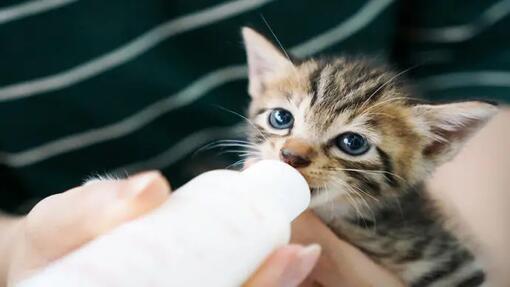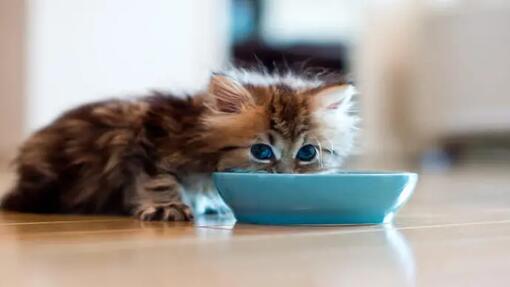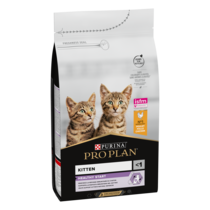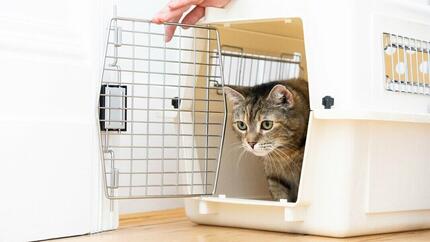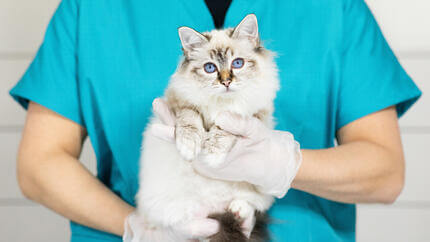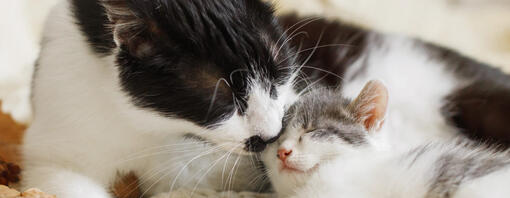
Kittenhood is amazing, but there comes a time in every cat’s life when they have to take their first step towards independence and leave kittenhood behind. It all starts with a process called weaning.
In most cases, you’ll receive your kitten at 8 weeks old and they’ll already be weaned, but there may be some circumstances where you receive them early, or you may end up with a litter on your hands by accidental breeding. Be aware that a reputable breeder will never sell an unweaned kitten or one that’s younger than 8 weeks of age.
Keep reading to find out when kittens are weaned and how to help your furball make a smooth transition from their mum’s milk to solid food. Be prepared, as it might get a bit messy.
When are kittens weaned?
Wondering when are kittens ready to start eating some delicious solid kitten food? Chances are your little furry friend is already biting and chewing all sorts of things, including their bottle. That’s usually a good sign that the kitten weaning process can start. This normally happens when the kitten is four weeks old.
But for kittens without their mum, weaning can start a bit earlier.
Kittens tend to have their own schedule when it comes to weaning and switching to solid food. Always check with your pet to make sure they’re ready for the big step. If their teeth have emerged and they seem to enjoy the change in the menu, continue the process for the next four weeks. But if you notice your kitten struggling to eat food and showing signs of lethargy and lack of energy, stick to milk for a bit longer before trying again.
It’s not always easy for owners to decide the right time when kittens are ready to start eating, but luckily vets are a phone call away. If you’re in any doubt about weaning your kitten, get in touch with a professional and they will guide you and your pet through the steps.
How to wean kittens in 5 easy steps
If you’ve decided now is the time to start the kitten weaning adventure, here are a few easy steps that will make the whole process easy and less messy for both of you.
1. Choose the right kitten food from the start
Starting with the right food will make a world of difference. Kitten-approved meals have a few things in common: they’re high in calories, don’t skimp on proteins, have a good percentage of fat and are highly-digestible. All this is important considering that your pet’s development depends on a diet that has a particular nutritional profile and designed to match the needs of a kitten in the process of growing healthy and strong. If in doubt, you can check out Purina’s range of kitten food and choose nutritionally balanced meals that won’t fail to impress your pet and their taste buds.
2. Get the right food bowls
Your kitten’s first food bowl is an exciting purchase. Kitten food bowls come with colourful, cute designs that will no doubt catch your eye. But to make life easier, you should also pay attention to the material they’re made out of and how deep or shallow their make is. Steel or ceramic food bowls are usually a better choice because plastic tends to scratch easily and bacteria will happily live in the resulting grooves. Keep in mind that some kittens are also allergic to plastic. Choose a shallow bowl so that your cat is able to get to the food without straining too much. You should always ensure that your kitten has a separate bowl for water that’s always fresh and filled, preferably away from their food bowl as cats don’t like their food and water to be too close together!
You can find out more about choosing the right bowl for your cat with our top tips.
3. Create a comfy nest for your kitten
Now that you’ve got all the supplies you need, it’s time to find the perfect place where your kitten can enjoy their meals. Make sure it’s away from their litter tray and choose a quiet location in the house that’s also easily accessible for your small furry friend. You can even use a few towels or a blanket to create a warm nest and make the whole experience of eating new food more relaxed and comfortable.
4. Keep the milk bottle going as the kitten gets used to solid food
The transition from milk to solid food should be gradual. Kitten weaning is a slow process and for good reason. Your pet doesn’t know any other food exists except for their mum’s milk or the formula in the bottle. It can be a bit overwhelming as they’re figuring out what eating is all about. Plus, the taste is yummy but so different. Supplementing with formula while your kitten is growing more comfortable with eating food means that they’ll be getting the calories they need no matter how happy or reluctant they are to accept the new meals. By week eight, they will have forgotten all about milk and will be ready to enjoy their meals completely solid.
5. Introduce your kitten to water too
Once your kitten is confident around their new food bowl, it’s time to introduce the other important bowl in any cat’s life: the water bowl. Make sure the water in it is not higher than about 2 inches and choose a steel or ceramic bowl that is not too deep.
Kitten weaning top tips
Now that you know got the basics of how to wean a kitten, here are few more ‘advanced’ kitten weaning tips your pet will no doubt appreciate.
Have a variety of wet and dry kitten food available
Some kittens will have no trouble munching on dry kibble, while others will turn their nose up at the sight of dry food and go for wet meals instead. Unfortunately, you won’t know which group your feline belongs to beforehand, so it’s always a good idea to have both dry and wet kitten food in the house, just in case.
Warm the food
Warming up the food for a few seconds in the microwave might seal the deal when you’ve got a picky kitten who is reluctant to let go of mum’s milk.
Use a mat
Weaning kittens can get messy pretty quickly. This is why placing the kitten’s food bowl on a mat is a great tip. Even if your cat spills the food or dribbles all over the place, the mat will catch most of the mess making cleaning a much easier job.
Create a feeding schedule
A good trick for kittens new to eating food is to keep them on a clear, regular schedule. Make their meals part of a daily routine by aiming for three to four meals a day. The entire family can synchronise meals with the little feline in the house and have breakfast, lunch and dinner together.
Be patient
Weaning kittens will typically take a few weeks, so it’s important not to rush your pet. Let the kitten decide when it’s time to start the process and take the lead from them when it comes to the quantity of solid food that they’re comfortable with at every stage. Slowly but surely, you’ll soon have a kitten strutting confidently to their food bowl for a delicious and completely solid meal.
How to wean an orphaned kitten?
If you’ve welcomed into the family an orphaned kitten, the weaning process is not much different, but it is usually advised to start a little bit earlier, at three weeks. As with kittens with moms around, look for clues that the little feline is ready for solid food: emerging teeth, biting and chewing. If they’re underweight or too small, you might need to wait a bit longer before weaning your kitten. As always, check with the vet to make sure you’re doing the right thing for your pet.
Next, find out if cats truly hate water and discover what to do if your kitten is drinking too much water.

